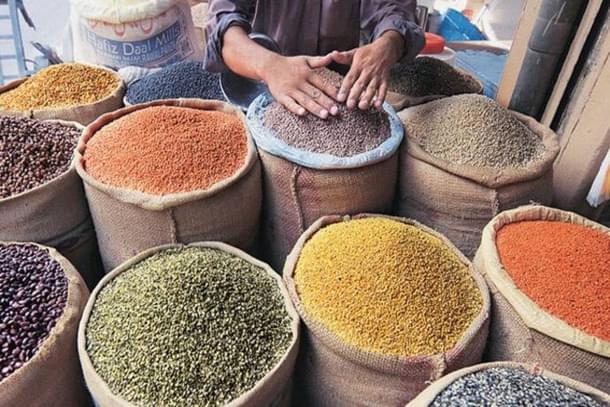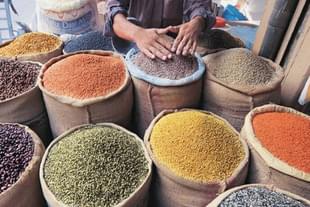Economy
Pulses Of Change: 3 Years After Repeal Of Farm Laws, Centre Turns To Contract Farming To Reduce Import Dependency
Amit Mishra
Nov 05, 2024, 03:14 PM | Updated 03:22 PM IST
Save & read from anywhere!
Bookmark stories for easy access on any device or the Swarajya app.


In a groundbreaking move, the government has launched a pilot project across Tamil Nadu, Bihar, Jharkhand, and Gujarat, signing contract farming agreements with local farmers to grow tur and masur pulses on 1,500 hectares of land.
This project, rolled out in collaboration with the National Cooperative Consumers' Federation of India (NCCF), is historic: it marks the government’s first foray into contract farming—almost three years after the repeal of the 2020 farm laws, one of which sought to provide a framework for such agreements.
At the heart of contract farming lies an agreement between farmers (producers) and buyers, where both parties agree in advance on the terms and conditions for the production and marketing of farm products. These conditions usually specify the price to be paid to the farmer, the quantity and quality of the product demanded by the buyer, and the date for delivery to the buyer.
While contract farming isn’t new to India—it’s already common in crops like sugarcane, cotton, and coffee—the government’s entry into this area, especially for pulses, signals a fresh approach to tackling India’s import dependency.
Why Pulses
Pulses are among the important food crops globally due to their higher protein content. However, they are one of the two agricultural commodities in which India is significantly import-dependent, the other being edible oil.
Out of the 29-30 million tonnes (mt) of pulses that the country consumes annually, around 27-28 mt comes from domestically produced grain. The remaining 2-3 mt is imported.
However, erratic rainfall has significantly impacted crop yields for two consecutive years, prompting the government to lift import restrictions to boost domestic supply. As a result, pulse imports have surged by an astounding 90 per cent, reaching 4.74 million tonnes in 2023-24.
From 27.3 million tonnes in FY22, the production of pulses fell to 26 million tonnes in FY23 and 24.5 million tonnes in FY24, according to agriculture ministry data.
The numbers only hint at a larger story. Experts warn that without policy changes, pulse imports could double to 8-10 million tonnes over the next five years.
“Self-sufficiency in pulse production cannot be achieved through ‘empty’ slogans. We need concerted policy action,” says Ashok Gulati, a distinguished economist at the Indian Council for Research on International Economic Relations (ICRIER).
The government has set a target of becoming self-sufficient in pulses by 2027 and has been promoting their production through incentives, including higher MSP and procurement initiatives like the Price Support Scheme (PSS) and Price Stabilization Fund (PSF).
Finance Minister Nirmala Sitharaman emphasized this in the Union Budget, declaring that the production, storage, and marketing of pulses and oilseeds would be prioritized to end import reliance.
The government’s recent move toward contract farming for pulses should be seen as part of this larger strategy. The pilot deal aims to boost self-sufficiency in pulses by encouraging cultivation in states less familiar with pulse farming.
Under this agreement, farmers will grow tur and masur on their land, while the NCCF will procure part of their produce at either the minimum support price (MSP) or the market rate—whichever is higher—for the government's buffer stock, reports the ET.
Although initial procurement will be modest, it is expected to expand over time, helping stabilize supply and prices for farmers and consumers alike.
Stumbling Block
The government's drive to boost domestic pulse production and reduce import reliance has seen notable success with yellow/white peas (matar) and chickpea (chana).
At their peak, yearly imports of these pulses reached 3 million tonnes for peas and 1 million for chickpeas, but have since dropped to nearly negligible levels.
However, the story has been different for arhar (pigeon pea) and masoor (red lentil), two pulses critical to the Indian diet.
Arhar production has been unpredictable, climbing from 3.17 million tonnes in 2013-14 to a peak of 4.87 million tonnes in 2016-17, only to slide back down to 3.43 million tonnes by 2022-23. Equally concerning is masoor, whose imports from Canada and Australia have crossed 1.1-1.2 mt in some years.
This likely sheds light on the government's renewed commitment to enhancing the production of these two vital crops. The path to achieving pulse self-sufficiency probably hinges on these efforts.





